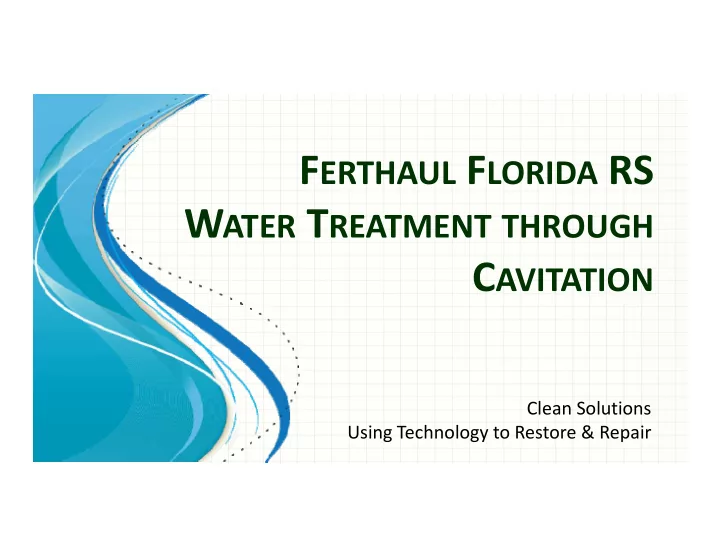

F ERTHAUL F LORIDA RS W ATER T REATMENT THROUGH C AVITATION Clean Solutions Using Technology to Restore & Repair
Ferthaul Florida RS • Performed free pilot on Lake Apopka in 2015 • Suctioned water and muck directly from lake • Treated water with Mitton Cavitation • Had DEP testing completed on water • Performed 43 days of testing in winter 2015 • Processed 8,500,000 gallons of canal water • Removed over 3 tones of Phosphorous
What is Cavitation? the formation of an empty space • within a solid object or body the formation of bubbles in a liquid, • typically by the movement of a propeller through it
Why Cavitation The extreme conditions of cavitation can break down pollutants and organic molecules Collapse of cavities generates hydoxyl ions, which are useful in realizing many benefits in effluent treatment Industrial Wastewater Treatment, Recycling and Reuse: Vivek V. Ranade, Vinay M Bhandari Butterworth ‐ Heinemann, Jul 21, 2014
Already found in Nature Cleaning Water
Action Plan Take advantage of Reduce/Reuse/Recycle Remove Phosphorus – Don’t spread it around Allow nature to re ‐ balance
Reduce – Reuse ‐ Recycle • R educe P and N through reduction of agriculture use • R euse the P and N for agriculture • R ecycle the water back to the lake
Process the Lower layer of Lake • Remove the lower layer with the highest content, said to range from 3 to over 17 feet thick • Separate using Parabolic screens and treat with Cavitation • Return the water to the lake with levels under 0.07 • Re ‐ purpose the slurry with P and N for other agriculture
T HE 2015 P ILOT S TUDY L AKE A POPKA From Google Maps
2015 Pilot • Barge with pump to suction influent from lake • Pumped to two 2500 gal holding tanks • Processed by Mitton Cavitation Valve • Returned to 2500 gal Tank • Decanted to second 2500 gal tank • Tested from top of second tank
Lake Apopka
Success! “Based on comparing the analytical chemistry sample results for the incoming dredge material (influent) and post ‐ process water (effluent), the pilot plant removed total phosphorus from 8.0 mg P/L in the influent sample to 0.25 mg P/L in the effluent sample. Similarly, total nitrogen was reduced from 150 mg N/L to approximately 4.4 mg N/L.” “The Department finds the results from this pilot project successful in reducing total phosphorus and total nitrogen.”
Pilot Lab Results
Before and After Pre and Post from bottom of Lake Post and Pre from Top of Lake
W INTER 2015 L AKE A POPKA C ANAL
Restoration Results • Treated Canal Water using dual CAV1000 Mitton Valves up to 1,000,000 Gal/day • Treated over 8,500,000 gallons in 43 days • Over 99.5% P removal, 7750 lbs removed • Sample slurry for agriculture
Treatment Results Sample Total P (mg/L) P (mg/L) All test results are from Date Untreated Treated Removed % Removed Flowers Laboratory 19 ‐ Oct 11.30 0.0020 11.298 99.982% 28 ‐ Oct 12.70 0.0737 12.6263 99.420% 2 ‐ Nov 77.60 0.0528 77.5472 99.932% 11 ‐ Nov 153.00 0.0506 152.9494 99.967% 18 ‐ Nov 32.00 0.0846 31.9154 99.736% 23 ‐ Nov 370.00 0.8290 369.171 99.776% 1 ‐ Dec 429.00 0.4020 428.598 99.906% 3 ‐ Dec 161.00 0.5830 160.417 99.638% 8 ‐ Dec 21.80 0.4790 21.321 97.803% 14 ‐ Dec 96.00 0.8420 95.158 99.123% 18 ‐ Dec 74.00 0.2520 73.748 99.659% 4 ‐ Jan 72.20 0.0460 72.154 99.936%
Phosphorous Removed vs Gallons 8,000,000 8,000 7,000,000 7,000 6,000,000 6,000 Total Gallons 5,000,000 5,000 Gallons Process Total P in lbs 4,000,000 4,000 Removed 3,000,000 3,000 2,000,000 2,000 1,000,000 1,000 ‐ ‐ 1 3 5 7 9 11 13 15 17 19 21 23 25 27 29 31 33 35 37 39 41
Daily Phosphorous Removal 300,000 800 700 250,000 Gallons of Canal Water Processed 600 200,000 500 150,000 400 Daily Gallons Processed 300 100,000 lbs of P 200 removed 50,000 100 ‐ ‐ 19 ‐ Oct 26 ‐ Oct 2 ‐ Nov 9 ‐ Nov 16 ‐ Nov 23 ‐ Nov 30 ‐ Nov 7 ‐ Dec 14 ‐ Dec
Dredging Area
Treatment Site
Site Configuration Untreated 153 mg/L P Tank A 0.136 mg/L P Tank B 0.0506 mg/L P
What to do with the Slurry?
Reuse of the Effluent • Test cells on SJRWMD land close to canal • Slurry applied to 4 cells – 1cell seeded with grass seed – 2 cells with thin layer applied – 1 cell with think layer • 2 cells left as control cells
The Slurry Dries in 4 Days
Cells mowed down and a divider vegetation left
Control Cell A Initial Jan 20 Final Feb 18
Cell B 4 inch thick slurry Initial Jan 20 Final Feb 18
Cell F – 6 days of seed growth
In 9 days seed had grown to 4“
Weed growth Comparison
Summary • Phosphorous ‐ 11.3 mg/L to 429 mg/L • Removal at 99.5% • Cost under $80 per lb of Phosphorus • +3.5 metric tones removed in 43 days from 8,500,000 gallons of canal water/muck • Slurry usable for Agriculture once composted
W HERE TO N EXT ? Q UESTIONS ?
Recommend
More recommend